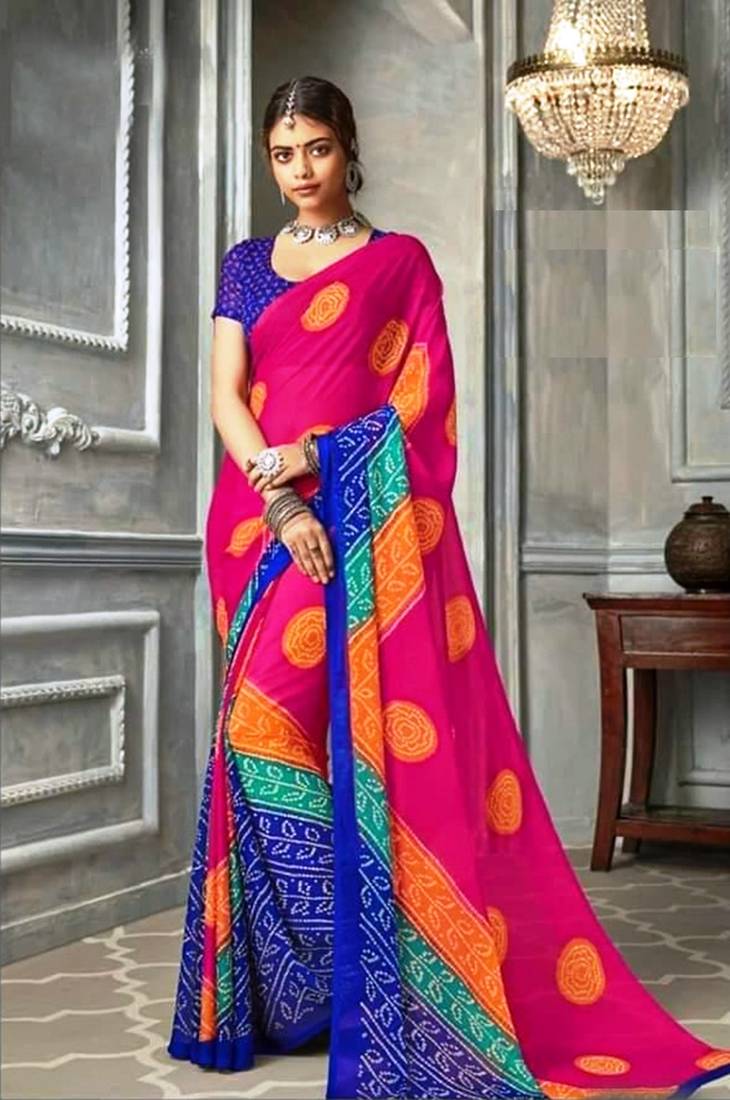Bedazzle Them With Bandhani Sarees!
Bandhani has its roots in the Kutch region of Gujarat. The tie and dye technique in Kutch is a family tradition kept alive by the Muslim Khatri community here, and the colors used are in keeping with time-tested traditions and they signify various stages in a person’s life or occasions that are celebrated with gusto. Thus, dark solid colors signify a woman or family in mourning, while yellow symbolize a new mother and red for a young girl in the bloom of youth.

The art of bandhani has cast its shadow on Rajasthan as well where it has gained popularity over time, but the designs used in Rajasthan differ from the ones in Gujarat. Certain prints are peculiar to Rajasthan, such as the Leheriya or wave pattern used for the bandhani here, which isn’t found anywhere else. The finest Bandhanis continue to be made in Rajasthan and Gujarat, although some crude forms of this tie-and-dye are seen in Sindh ( Pakistan) and Uttar Pradesh too.

Bandhani or Bandhej is a traditional resist dyeing method where the cloth is tied to make designs using tiny dots, and dyes are filled in starting from the light colors to the dark. There are various designs made with the use of a few major colors like red, black, blue, maroon, yellow. Depending on the patterns and the materials used, the end product may be a Chandrakhani, Gharchola, Panetar, or Kombi.
The Chandrakhani is worn by Khatri brides and is characterized by round circular patterns that stand for the moon and is set against a blue-black background. The Ghar Chola is a bandhani lined with zari checks and is a traditional wedding saree worn by brides in the Lohana community.

In Rajasthan, the Leheriya pattern is made of dots arranged in a wave pattern signifying water and is worn during the monsoon, especially during the Teej festival. There are other patterns too, prevalent in Rajasthan, such as Mothra, Ekdalia, and Shikari, most of which depict animals and birds using dots.
Originally Bandhani was used on turbans, Odhnis, sarees, and skirts in Gujarat and Rajasthan using fabrics like fine cotton mulmul and fine silk since these are most suitable for the resist dyeing technique used. The Rabari women, incidentally, wore bandhani on coarse woolen cloth as Odhnis. Today, with modern methods and computerized techniques, the process is no longer as time-consuming and labor-intensive as it was in the past. Bandhani saree can also be easily worked on a variety of fabrics today, such as georgette, chiffon, viscose, and synthetic blends.

The colors used have also moved from the traditional ones to a myriad lighter hue. However, the designs of Jamnagar, Jaipur, and Sikar continue to be cherished for their intricacy and fine execution, as are traditional shades of red, maroon, and the like. The qualities of modern drapes have only added to the beauty of Bandhej products today.
Type of Fabric used in Bandhani Sari:
Here are some modern takes on traditional Bandhej on sarees that stand out in their distinctive uniqueness. The most popular varieties are listed here to help you take your pick:
Chiffon Bandhani Saree: The most appreciated element in a Chiffon Bandhani is its sensuous drape and smooth, flowy texture. Pair your sari with some simple pair of colored earrings and matching bangles to make the sari stand out.

Crepe Bandhani Saree: A crepe bandhani has a silky, lustrous look that looks great when teamed with an elegant neckline or a halter blouse to match. Crepe Bandhani is available in the widest range of colors to choose from for any and every occasion, and are most suited for the modern Indian woman.

Viscose Bandhani Saree: Choose Viscose Bandhani Saree if you are looking for an impressive shade in a specific color. There is a wide range of shaded colors available in this segment.
Georgette Bandhani Saree: Georgette Bandhani Saree perfectly complements a wide range of laces and embellishments, and is the designer's choice to come up with the best creation in the market.